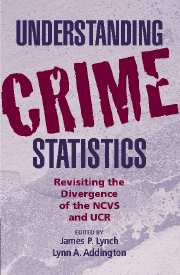Book contents
- Frontmatter
- Contents
- Acknowledgments
- Contributor Biographies
- INTRODUCTION
- OVERVIEW OF THE TWO NATIONAL MEASURES OF U.S. CRIME
- DEFINING DIVERGENCE AND CONVERGENCE
- SOURCES OF DIVERGENCE IN THE NCVS
- 5 Methodological Change in the NCVS and the Effect on Convergence
- 6 Series Victimizations and Divergence
- 7 Exploring Differences in Estimates of Visits to Emergency Rooms for Injuries from Assaults Using the NCVS and NHAMCS
- SOURCES OF DIVERGENCE IN THE UCR
- CONCLUSION
- Index
- CAMBRIDGE STUDIES IN CRIMINOLOGY
- References
5 - Methodological Change in the NCVS and the Effect on Convergence
Published online by Cambridge University Press: 23 December 2009
- Frontmatter
- Contents
- Acknowledgments
- Contributor Biographies
- INTRODUCTION
- OVERVIEW OF THE TWO NATIONAL MEASURES OF U.S. CRIME
- DEFINING DIVERGENCE AND CONVERGENCE
- SOURCES OF DIVERGENCE IN THE NCVS
- 5 Methodological Change in the NCVS and the Effect on Convergence
- 6 Series Victimizations and Divergence
- 7 Exploring Differences in Estimates of Visits to Emergency Rooms for Injuries from Assaults Using the NCVS and NHAMCS
- SOURCES OF DIVERGENCE IN THE UCR
- CONCLUSION
- Index
- CAMBRIDGE STUDIES IN CRIMINOLOGY
- References
Summary
Historically the National Crime Victimization Survey (NCVS) and the Uniform Crime Reports (UCR) have provided different estimates of crime at the national level. Of the two, the NCVS traditionally reported more crime than recorded by police. In 2001, however, the number of serious violent crimes recorded by the police exceeded the number of crimes that victims said they reported to the police in the NCVS. This recent correspondence is the culmination of more than a decade of gradual convergence and raises important issues regarding the measurement of serious violent crime, particularly over time.
One of these issues is whether changes in the methodology employed in the NCVS could be contributing to the convergence with UCR estimates. Research shows that methodological change in the NCVS creates within series variation over time (Biderman and Lynch, 1991), yet the effect of such change remains largely ignored since the NCVS redesign in the early 1990s. This chapter examines whether the recent convergence between reported crimes in the NCVS and recorded crimes in the UCR is influenced by long-term methodological change in the victimization survey.
The chapter opens with an outline of the methodological changes to the survey and their potential effect on correspondence; a discussion of data sources and the construction of the variables used in the subsequent analysis follows. The results indicate that, except for changes in response rates and to a lesser extent computer-assisted telephone interviewing (CATI), changes in the NCVS design had minimal effect on the observed correspondence of the two series.
- Type
- Chapter
- Information
- Understanding Crime StatisticsRevisiting the Divergence of the NCVS and the UCR, pp. 125 - 155Publisher: Cambridge University PressPrint publication year: 2006
References
- 1
- Cited by



